The Yucatan Peninsula: A Rich Colonial History

Introduction
The Yucatan Peninsula is a gem of history and culture, boasting a rich colonial history that dates back centuries. This magical region, located in southeastern Mexico, is steeped in ancient Mayan traditions and colonial influences.
From the moment you set foot here, you can feel the vibrant energy pulsating through its streets, a testament to its captivating past. One of the standout cities in Yucatan’s colonial history is Merida.
As the capital city of the region, Merida proudly showcases its cultural heritage through its stunning colonial architecture and vibrant markets. Strolling through its historic center, you’ll be greeted by beautiful pastel-colored buildings that exude an old-world charm.
Don’t miss out on exploring the bustling marketplaces where you can taste local delicacies like cochinita pibil (slow-roasted pork marinated in citrus juices) or refreshing horchata (a rice-based drink). Izamal is another enchanting town that captures the essence of Yucatan’s rich colonial history.
Known as the “Yellow City,” Izamal dazzles visitors with its striking yellow facades that stretch as far as the eye can see. The town’s main attraction is undoubtedly the impressive Franciscan monastery atop an ancient Mayan pyramid.
Climb to the top for breathtaking views and immerse yourself in this unique blend of Mayan and colonial influences. Yucatan is also home to Valladolid, a charming town nestled between ancient Mayan ruins and mesmerizing cenotes (natural sinkholes).
Its well-preserved Spanish Colonial architecture transports you back in time, while nearby attractions like Chichen Itza and Ek Balam showcase some of Mexico’s most renowned archaeological wonders. Hoctun offers a different glimpse into Yucatan’s past with its underground cenote system.
These mystical sinkholes were revered by the ancient Maya who considered them sacred sites. Take a dip into these refreshing turquoise waters and marvel at the natural beauty that lies beneath the surface.
The Yucatan Peninsula’s colonial history is not only reflected in its towns and cities but also in its people, their traditions, and their way of life. Exploring this region allows you to immerse yourself in a captivating blend of ancient Mayan heritage and Spanish colonial influences, creating an unforgettable experience that will leave an indelible mark on your soul.
The Most Popular Colonial Towns in Yucatan
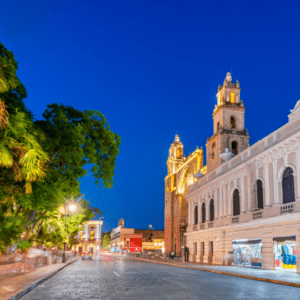
When it comes to exploring the colonial charm of the Yucatan Peninsula, you can’t miss visiting its most popular colonial towns. These quaint and picturesque destinations are like stepping back in time, with their cobblestone streets, colorful facades, and rich historical significance. One such town that should be at the top of your list is Valladolid.
Located in the heart of Yucatan, Valladolid showcases a perfect blend of Mayan and colonial influences. As you stroll through its vibrant streets, you’ll be captivated by the beautifully preserved pastel-colored buildings and charming squares adorned with fountains and statues.
Don’t forget to visit the Cenote Zaci while you’re here – a stunning underground sinkhole that offers relief from the tropical heat. Another gem on your itinerary should be Izamal, famously known as the “Yellow City” due to its golden-hued buildings.
This small town is a true testament to Mexico’s cultural heritage, with its ancient Mayan ruins juxtaposed against Spanish colonial architecture. The towering pyramids at Kinich Kak Moo are a must-see attraction for history enthusiasts and offer breathtaking views of this enchanting town.
If you’re seeking a more off-the-beaten-path experience, make sure to include a visit to Hoctun in your travel plans. This charming little town may not be as well-known as Merida or Valladolid but has much to offer in terms of natural beauty and historical sites.
One highlight is its unique underground cenote – an underground cave filled with crystal-clear water that offers a refreshing escape from the heat of the Yucatan sun. Don’t forget to explore Ticul during your colonial towns adventure.
This small town boasts not only beautifully preserved colonial architecture but also an impressive Mayan temple complex located right within its boundaries. Immerse yourself in Ticul’s vibrant culture by visiting local pottery workshops where talented artisans create exquisite clay pottery using traditional techniques passed down through generations.
The Yucatan Peninsula is a treasure trove of colonial towns waiting to be discovered. Whether you choose to wander the streets of Merida, Valladolid, Izamal, Hoctun, or Ticul, each town offers its own unique charm and cultural experiences.
From wandering through ancient Mayan ruins to marveling at colonial architecture and indulging in local cuisine, these towns provide an authentic taste of Mexico’s history and culture. So pack your bags and get ready to embark on an unforgettable journey through the colonial heartland of the Yucatan Peninsula.
Why You Need to Visit Yucatan’s Colonial Towns

If you’re planning a trip to Yucatan, make sure to include a visit to the charming colonial towns that dot the region. Trust me, these towns are not to be missed!
Why, you ask? Well, let me tell you.
First of all, each town has its own unique character and vibe that will transport you back in time. Take Merida for example, the capital of Yucatan.
Known as “The White City,” it showcases a rich colonial history with its stunning architecture and vibrant cultural scene. And if you’re looking for a town that perfectly blends Mayan and colonial influences, Valladolid is the place to be.
Walking through its narrow streets lined with colorful buildings and exploring its bustling main square will give you an authentic taste of Mexico’s history and culture. But it’s not just about the visuals; these colonial towns offer so much more!
If you’re a foodie like me, then get ready to tantalize your taste buds with some mouthwatering local cuisine. No trip to Yucatan is complete without trying out their gastronomic delights like cochinita pibil (slow-roasted pork), panuchos (tortillas topped with black beans, shredded turkey or chicken, pickled onions, and avocado), or sopa de lima (lime soup).
These traditional dishes will take your palate on an unforgettable journey. And let’s not forget about the fascinating historical sites nearby!
Many of these towns are surrounded by ancient Mayan ruins waiting to be explored. Whether it’s visiting the majestic pyramids at Chichen Itza near Valladolid or discovering the hidden gems like Mayapan near Merida, there is no shortage of archaeological wonders in this region.
Besides immersing yourself in history and indulging in fantastic food options, visiting Yucatan’s colonial towns also gives you a chance to experience the warm hospitality of the locals. They are proud of their heritage and are always eager to share stories about their town’s past and present.
Don’t be shy to strike up a conversation and ask for recommendations; you might stumble upon hidden gems or local events that will make your visit even more memorable. So, if you’re planning a trip to Yucatan, make sure to include some time exploring these colonial towns.
Immerse yourself in the vibrant culture, indulge in delicious local cuisine, uncover ancient Mayan ruins, and connect with the friendly locals. Trust me, these towns will leave an indelible mark on your heart and provide an experience like no other.
The Towns

When it comes to exploring the vibrant culinary scene in Yucatan, you can’t miss visiting the charming colonial towns scattered throughout the region. These towns not only offer a feast for your taste buds but also provide a glimpse into the rich history and culture of Yucatan. So, let’s embark on a mouthwatering adventure as we delve into some of these delightful towns.
First up is Merida, the bustling capital city of Yucatan. Known for its vibrant markets and lively atmosphere, Merida is a food lover’s paradise.
Here you will find a wide array of traditional dishes such as cochinita pibil (slow-roasted pork marinated in aromatic spices) and poc chuc (grilled pork marinated in citrus juices). The city is dotted with various food stalls and local eateries where you can savor authentic Yucatecan flavors passed down through generations.
Next on our culinary journey is Valladolid, a town that seamlessly blends Mayan and colonial influences. This quaint little town offers an abundance of gastronomic delights, with its central market being one of the highlights.
Explore the market stalls brimming with colorful fruits, vegetables, spices, and local delicacies like papadzules (rolled tortillas filled with hard-boiled eggs covered in pumpkin seed sauce). Don’t forget to try some refreshing horchata or jamaica agua fresca to quench your thirst.
Moving along, we arrive at Izamal – also known as the “Yellow City” due to its golden-hued buildings. Besides being visually captivating, Izamal boasts an enticing food scene too.
You can indulge in traditional dishes such as sopa de lima (lime soup) or try out their famous cochinita pibil tacos topped with tangy pickled onions. After satisfying your cravings for local cuisine, take a stroll through this magical town that proudly showcases both Mayan ruins and colonial architecture.
Ticul, a small town located in the southern part of Yucatan, is our next stop. While Ticul may not be as well-known as other colonial towns, it offers a delightful culinary experience.
One of its highlights is the market where you can find an array of regional ingredients and traditional snacks like panuchos (tortillas topped with refried beans, turkey or chicken, and garnished with pickled onions and avocado). With its proximity to various cenotes (natural sinkholes), you can also enjoy a refreshing swim after your food adventures.
We have Hoctun, a town that surprises visitors with its unique underground cenote. After exploring this geological wonder, make sure to treat yourself to some local delicacies.
From poc chuc tacos to sikil pak (a dip made from roasted pumpkin seeds), Hoctun offers plenty to excite your taste buds. These towns are just a glimpse into the vast culinary landscape of Yucatan.
Each one has something special to offer – be it traditional recipes passed down through generations or modern interpretations of classic dishes. So, come hungry and ready to immerse yourself in the flavors and culture of Yucatan’s enchanting colonial towns.
Merida: The Capital of Yucatan

Merida, the capital of Yucatan, is a vibrant and fascinating city that perfectly embodies the rich history and culture of the region. As soon as you step foot in Merida, you’ll be captivated by its charming colonial architecture, colorful streets, and warm-hearted locals.
This city is truly a food lover’s paradise, offering a wide range of culinary delights that will leave your taste buds dancing with joy. One cannot talk about Merida without mentioning its iconic dish – cochinita pibil.
This mouthwatering delicacy consists of slow-roasted pork marinated in a flavorful blend of spices and wrapped in banana leaves. The result is tender meat that practically melts in your mouth, accompanied by tangy pickled onions and served on soft corn tortillas.
You can find this delectable treat at various street stalls and local restaurants across the city. When it comes to exploring Merida’s food scene further, you’ll find an abundance of local markets known as “mercados” where you can immerse yourself in the vibrant colors and exotic aromas.
A visit to Mercado Lucas de Gálvez or Mercado San Benito is a must for any food enthusiast. Here, you can wander through countless stalls selling everything from fresh fruits and vegetables to an array of spices, chili peppers, and traditional Yucatecan products like recado rojo (a red seasoning paste) or achiote paste.
For those seeking more upscale dining experiences, Merida boasts several renowned restaurants that blend traditional flavors with modern techniques. From fusion cuisine combining Yucatecan ingredients with international influences to contemporary twists on classic dishes like sopa de lima (lime soup) or papadzules (tortillas filled with hard-boiled eggs), these establishments cater to every palate.
To truly appreciate the culinary wonders of Merida while also taking in its historical charm, make sure to visit one of its many cenotes. These natural sinkholes, often filled with crystal-clear turquoise waters, are not only perfect for a refreshing swim but also showcase the ecological richness of the Yucatan Peninsula.
Many cenotes have restaurants nearby where you can indulge in delicious traditional meals after your dip. Merida is a city that seamlessly blends history, culture, and gastronomy to create an unforgettable experience for travelers.
Whether you’re exploring its colonial streets, indulging in local delicacies like cochinita pibil, or discovering the enchanting cenotes nearby, Merida is sure to leave a lasting impression on your palate and your heart. So pack your bags and get ready for a culinary adventure like no other in this captivating city in the heart of Yucatan.
Valladolid: A Charming Town with a Mix of Mayan and Colonial Influences
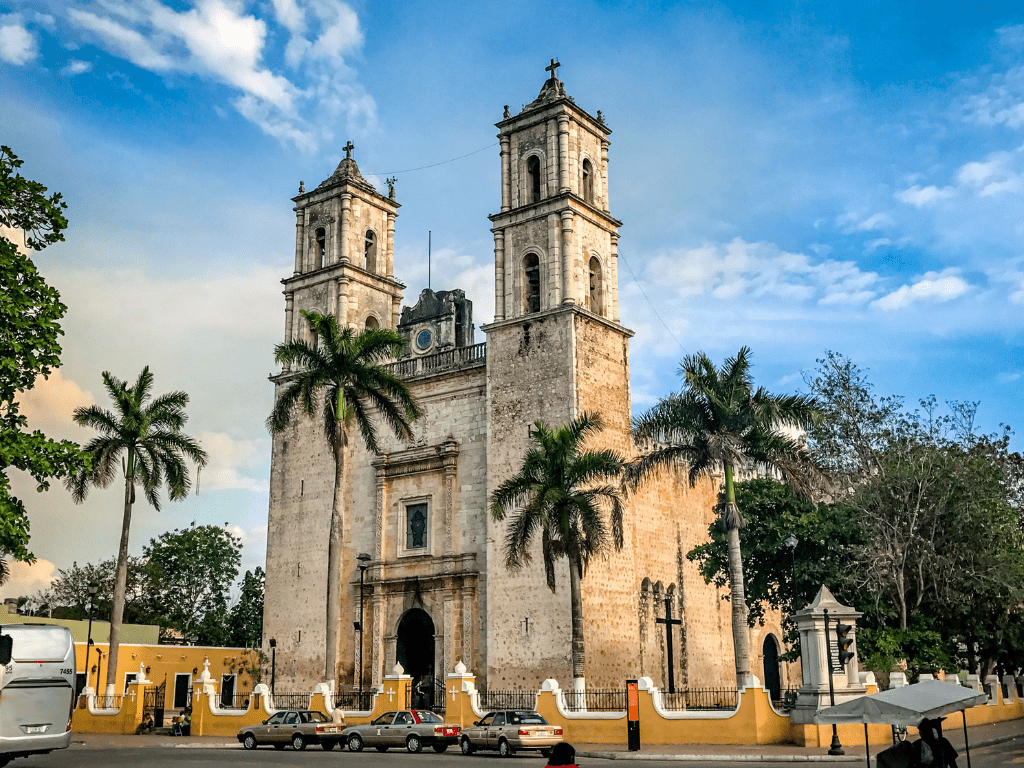
Valladolid is a charming town located in the heart of the Yucatan Peninsula, and it’s a must-visit destination for any food lover or travel enthusiast. This town perfectly captures the mix of Mayan and colonial influences that make Yucatan’s culture so unique.
As you stroll through its picturesque streets, you’ll be captivated by the colorful colonial buildings adorned with vibrant bougainvillea flowers. One of the highlights of Valladolid is its vibrant food scene.
The local cuisine here is a fusion of indigenous Mayan flavors and Spanish colonial culinary techniques. You simply cannot leave without trying some of the mouthwatering dishes that represent this delicious blend.
Start your culinary adventure by sampling cochinita pibil, a traditional Mayan dish made with slow-roasted pork marinated in sour orange juice and annatto paste, wrapped in banana leaves for an explosion of flavor. To satisfy your sweet tooth, indulge in some marquesitas—a popular snack made from crispy rolled-up crepes filled with melted Edam cheese and your choice of toppings like Nutella or caramel sauce.
It may sound unusual, but trust me, once you take your first bite, you’ll be hooked! In between meals, take some time to explore Valladolid’s rich history and cultural attractions.
The town boasts stunning examples of colonial architecture such as the San Gervasio Cathedral, which towers over the main square known as Parque Francisco Canton Rosado. Inside the cathedral, you’ll find beautiful artwork and intricate designs that pay homage to both Spanish Catholicism and Mayan traditions.
For those seeking adventure beyond gastronomy and architecture, Valladolid offers proximity to several fascinating cenotes—natural sinkholes filled with crystal-clear freshwater that were considered sacred by ancient Mayans. Head to Cenote Zaci located just minutes away from downtown Valladolid if you want to cool off in its refreshing turquoise waters surrounded by lush vegetation and hanging vines.
Whether you’re a history buff, a food lover, or simply looking to immerse yourself in the captivating culture of Yucatan, Valladolid is the ideal destination. Its mix of Mayan and colonial influences, vibrant culinary scene, and historical landmarks make it an essential stop on your journey through this remarkable region.
Izamal: The “Yellow City” of Yucatan
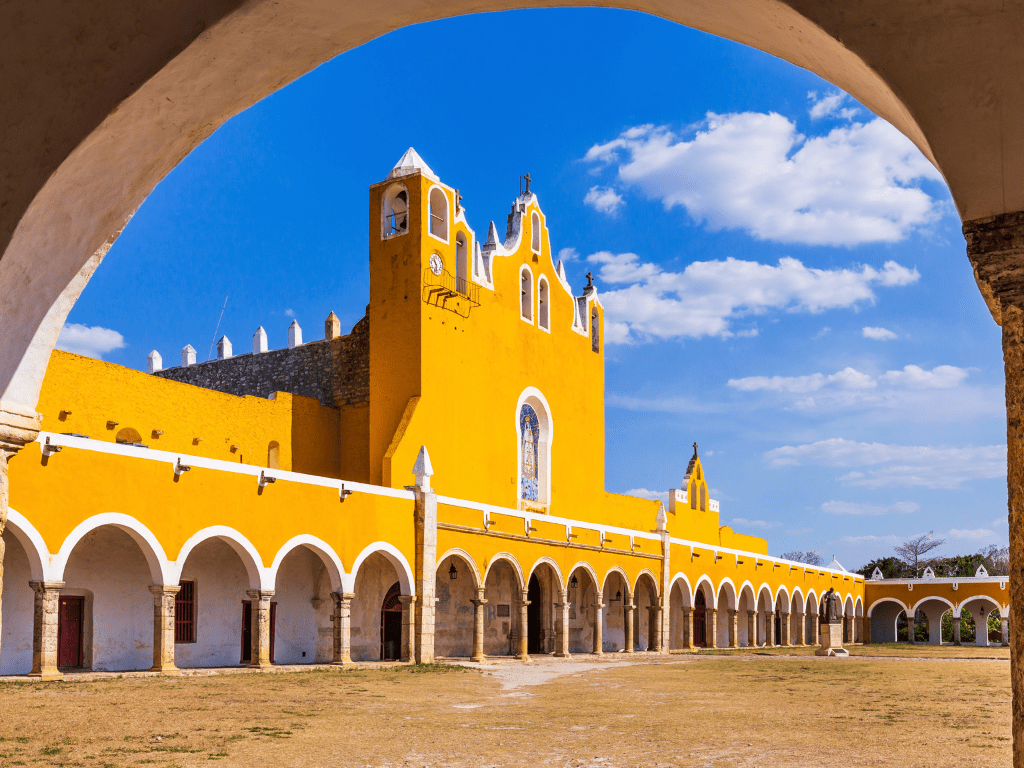
Located in the heart of the Yucatan Peninsula, Izamal is a small town with a big personality. It has earned its nickname as the “Yellow City” due to its vibrant yellow buildings that line the streets, creating a cheerful and inviting atmosphere.
As you stroll through the town, you can’t help but feel captivated by its colonial charm mixed with Mayan influences. Izamal is not only visually stunning but also steeped in history.
The town was once an important religious center for the ancient Mayans and served as a pilgrimage site for worshippers of Itzamatul, one of their prominent gods. Today, remnants of this rich Mayan heritage can be seen in the form of impressive ruins scattered throughout Izamal.
One of the most prominent attractions in Izamal is the Kinich Kakmó pyramid, dedicated to Kinich Kakmó, the Mayan sun god. This majestic structure stands tall and provides breathtaking views over the town and surrounding landscape.
Climbing to its summit is an absolute must-do for any adventurous traveler. Aside from its historical significance, Izamal offers a unique cultural experience.
The local community takes great pride in preserving their traditions and customs. Strolling through the streets during traditional festivals or religious ceremonies will immerse you in authentic Mexican culture at its finest.
When it comes to cuisine, Izamal doesn’t disappoint either. You’ll find local food stalls offering mouthwatering dishes that blend traditional Mayan flavors with modern twists.
Don’t miss out on trying specialties like cochinita pibil (slow-roasted pork marinated in citrus juices and spices) or papadzules (tortillas filled with hard-boiled eggs and topped with pumpkin seed sauce). In addition to exploring Izamal’s historical sites and indulging in delectable cuisine, make sure to take time to wander through its charming streets adorned with colorful flowers and picturesque buildings.
The warm and friendly locals are always ready to share interesting stories and recommendations, adding a personal touch to your visit. Visiting Izamal is like stepping into a living postcard.
With its stunning yellow architecture, ancient Mayan ruins, vibrant cultural events, and tantalizing cuisine, this “Yellow City” is an absolute gem in the Yucatan Peninsula. So next time you find yourself traveling in Mexico, don’t miss the opportunity to experience the magic of Izamal firsthand.
Ticul: A Small Town with a Well-Preserved Mayan Temple Complex
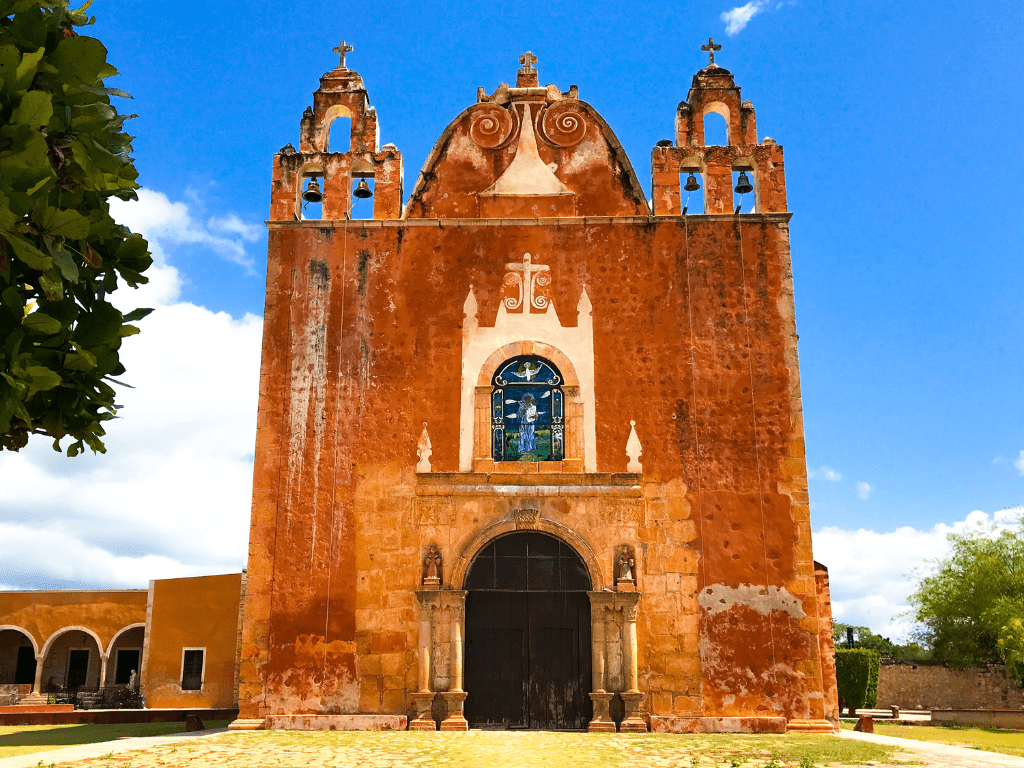
Ticul, a small town nestled in the heart of the Yucatan Peninsula, offers visitors a unique glimpse into Mayan history and culture. One of its most remarkable attractions is the well-preserved Mayan temple complex that stands as a testament to ancient civilizations. As you wander through the complex, you can’t help but feel awe-inspired by the intricate carvings on the stone walls and the grandeur of the architecture.
The site provides a fascinating window into the rich history of this region. Ticul’s Mayan temple complex is truly a hidden gem that often gets overshadowed by more popular destinations like Valladolid or Merida.
However, those who venture off the beaten path will be rewarded with an unforgettable experience. The tranquility and authenticity of Ticul create an atmosphere that transports you back in time.
Immersing yourself in Ticul’s culture goes beyond exploring its historical sites. This charming town also offers opportunities to interact with friendly locals who take pride in their traditions and craftsmanship.
The streets are lined with artisan workshops where talented craftspeople create intricate pottery and embroidery, offering visitors a chance to witness their skills firsthand. After exploring the Mayan ruins and getting lost in Ticul’s cultural wonders, make sure to indulge your taste buds at one of its vibrant local markets or street food stalls.
Sample traditional dishes such as cochinita pibil, a slow-roasted pork marinated in citrus juices and annatto seed paste wrapped in banana leaves for hours until it becomes tender and juicy. Don’t forget to pair it with some handmade tortillas made from scratch using local corn!
As you savor these delicious flavors, take a moment to appreciate how Yucatan’s cuisine is influenced by both Mayan and colonial influences. The fusion of indigenous ingredients like habanero chilies and tropical fruits with Spanish culinary techniques creates a unique culinary tapestry that will leave your taste buds begging for more.
Ticul might not be as well-known as its neighboring colonial towns, but its well-preserved Mayan temple complex and vibrant local culture make it a worthwhile stop on your Yucatan adventure. So, if you’re looking to uncover hidden gems, immerse yourself in history and culture, and indulge in mouthwatering local cuisine, Ticul should definitely be on your travel radar.
Hoctun: A Town with a Unique Underground Cenote

Nestled in the heart of the Yucatan Peninsula, Hoctun is a hidden gem that should not be missed on your culinary adventure through Yucatan. While it may not be as well-known as its neighboring towns like Valladolid or Merida, Hoctun offers a unique experience that will leave you in awe. One of its most remarkable features is the underground cenote located right in the center of town.
Picture this: descending into a mystical world where stalactites hang from above and crystal-clear turquoise water shimmers below. The cenote’s natural beauty is truly breathtaking, and taking a dip in its cool waters is an absolute must-do activity while visiting Hoctun.
Hoctun’s underground cenote carries with it an air of mystery and history that adds to its allure. Legend has it that the ancient Mayans considered these cenotes to be sacred portals to communicate with their gods.
As you explore this fascinating natural wonder, you can’t help but feel connected to the ancient civilizations that once thrived in this region. The echoes of their rituals and reverence for nature seem to resonate through every corner.
When you’re done marveling at the underground wonders of Hoctun’s cenote, take some time to explore the town itself. Its charming streets are lined with colorful houses adorned with vibrant flowers, showcasing a delightful mix of Mayan and colonial influences.
You’ll find friendly locals going about their daily routines, eager to share stories about their town’s rich history and culture. While small in size, Hoctun offers some delectable culinary delights that will satisfy even the most adventurous food enthusiasts.
Don’t miss out on tasting traditional Yucatecan dishes such as cochinita pibil (slow-roasted pork marinated in citrus juices and spices) or papadzules (rolled tortillas filled with hard-boiled eggs bathed in pumpkin seed sauce). The local eateries in Hoctun take great pride in preserving the authentic flavors of Yucatecan cuisine, offering you a truly immersive experience.
Visiting Hoctun allows you to dive deep into the soul of Yucatan, exploring its natural wonders, connecting with its ancient past, and savoring the unique flavors of its local cuisine. So make sure to include this hidden treasure on your itinerary when venturing through the enchanting colonial towns of Yucatan.
Where to Find the Best Colonial Towns
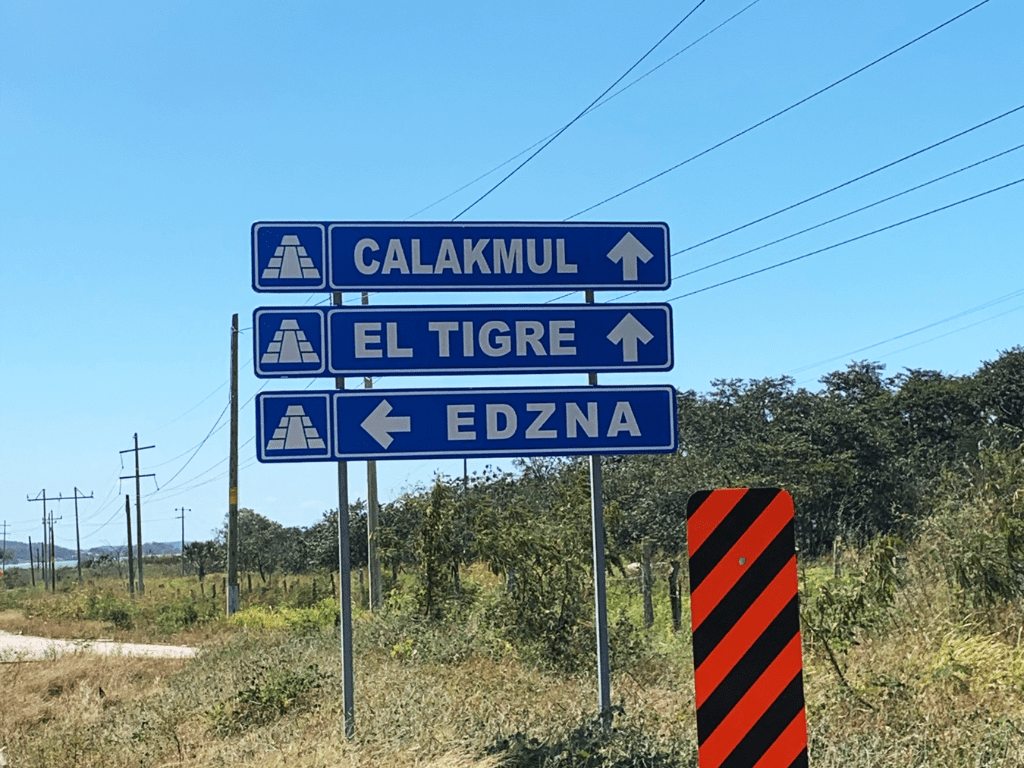
When it comes to finding the best colonial towns in Yucatan, you’ll be spoiled for choice. Each town has its own unique charm and allure, making it difficult to pick just one favorite. One of the must-visit towns is Valladolid, with its colorful facades and cobblestone streets that transport you back in time.
As you stroll through the town center, you’ll encounter quaint shops selling handicrafts and local delicacies. The main square is the perfect spot to sit and people-watch while enjoying a refreshing agua fresca.
Another gem is Merida, the capital of Yucatan. This vibrant city is known for its stunning architecture that showcases a blend of Spanish colonial and Mayan influences.
You can spend hours wandering through the bustling markets, where vendors offer an array of fresh fruits, spices, and traditional snacks like panuchos and salbutes. For a more offbeat experience, head to Ticul, a small town celebrated for its well-preserved Mayan ruins and pottery craftsmanship.
As you explore this hidden gem, don’t miss out on tasting traditional Yucatecan dishes like cochinita pibil or papadzules at local eateries tucked away in charming corners. If you’re up for an adventure off the beaten path, Hoctun is worth considering.
This lesser-known town boasts a unique underground cenote that captivates visitors with its natural beauty. After exploring this geological wonder, indulge yourself in some locally grown chocolate or sip on a cup of aromatic Yucatecan coffee at one of Hoctun’s cozy cafes.
Yucatan’s colonial towns are not just about their architectural splendor; they are also gateways to experiencing the rich culture and history of Mexico. So no matter which town you choose to visit – Valladolid’s vibrant streetscapes or Ticul’s cultural heritage – be prepared to immerse yourself in unforgettable flavors while discovering the fascinating stories of the Yucatan Peninsula.
The Best Time to Visit Yucatan’s Colonial Towns
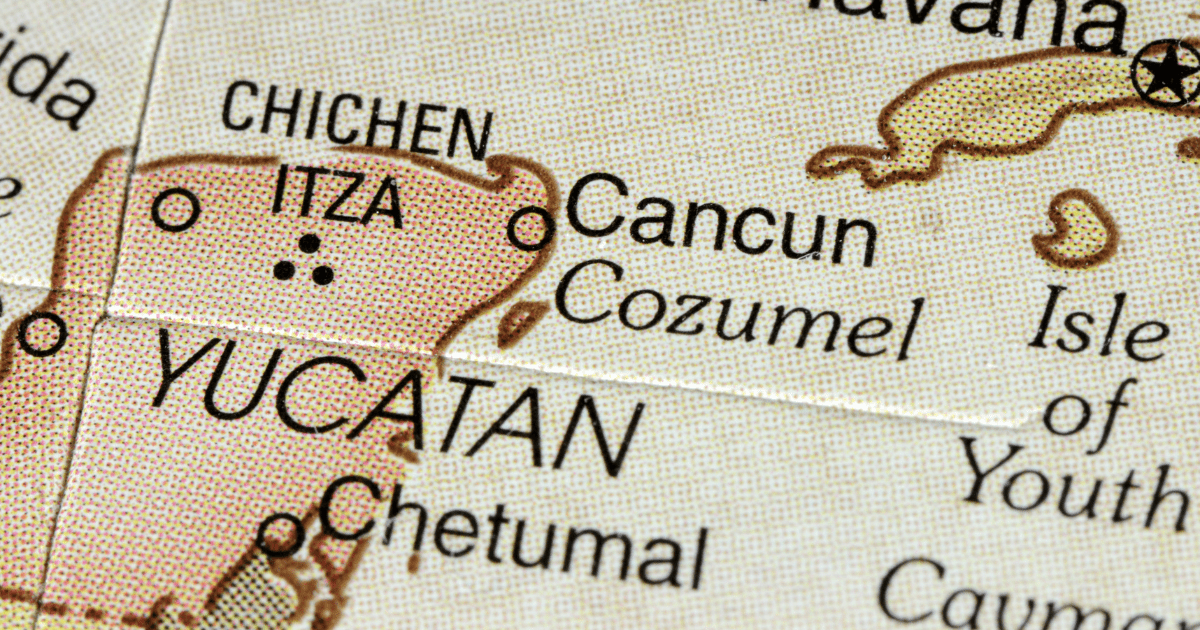
When it comes to exploring Yucatan’s colonial towns, timing can greatly enhance your experience. The best time to visit these charming towns is during the cooler months, from November to March. This period offers moderate temperatures and lower humidity, allowing you to comfortably explore the streets without feeling like you’re melting under the Mexican sun.
In addition, visiting during this time means avoiding the peak tourist season that usually occurs in the summer months. You’ll have a better chance of enjoying smaller crowds and a more intimate experience as you wander through the cobblestone streets of Merida or Valladolid.
Another factor to consider when planning your visit is any local festivals or events happening in these towns. Yucatan is known for its vibrant celebrations and cultural activities that showcase its rich history and traditions.
For example, Merida hosts “La Noche Blanca” (The White Night) where art exhibitions, concerts, and performances take place throughout the city until dawn. This event offers a unique opportunity to immerse yourself in the local culture while exploring colonial architecture.
Furthermore, if you’re a photography enthusiast or simply want to capture stunning shots of these picturesque towns, visiting during sunrise or sunset can provide breathtaking lighting conditions. The warm golden hues illuminating the colorful facades and narrow streets create an enchanting atmosphere that will undoubtedly make your photos stand out.
It’s worth mentioning that some colonial towns also serve as ideal bases for exploring nearby natural wonders such as cenotes or Mayan ruins. Hoctun, for instance, boasts an extraordinary underground cenote where you can cool off from the tropical heat by taking a refreshing dip in crystal-clear waters surrounded by ancient rock formations.
Ultimately, choosing when to visit Yucatan’s colonial towns depends on your personal preferences and priorities. Whether it’s mild weather conditions, cultural events, capturing magical moments with your camera or combining city exploration with natural wonders; there’s no shortage of options to ensure you have an unforgettable journey through the heart of Yucatan’s history and culture.
How to Explore Yucatan’s Colonial Towns

When it comes to exploring the charming colonial towns of Yucatan, there are a few tips and tricks that can enhance your experience and make your journey even more memorable. First and foremost, take the time to immerse yourself in the culture and history of each town you visit. Wander through the cobblestone streets of Merida, with its vibrant markets and stunning colonial architecture.
Feel the ancient energy as you explore the Mayan ruins in Izamal or Ticul, where you can marvel at the intricate stone carvings and towering pyramids. To truly appreciate the beauty of Yucatan’s colonial towns, it’s also important to venture off the beaten path.
Don’t be afraid to explore lesser-known gems like Hoctun, a town that boasts a unique underground cenote perfect for a refreshing swim after a day of sightseeing. And speaking of sightseeing, be sure to take advantage of any guided tours available in each town.
These tours will not only provide you with fascinating historical insights but also help you discover hidden corners and secret stories that might otherwise go unnoticed. Another essential aspect of exploring Yucatan’s colonial towns is interacting with locals.
Strike up conversations with shop owners, artists, or even fellow travelers along your journey. Learn about their traditions, their favorite local dishes (perhaps they’ll recommend trying poc chuc or salbutes), or ask for recommendations on must-see attractions within each town.
Don’t rush through your exploration; take your time and savor every moment. Each town has its own unique charm and atmosphere waiting to be discovered if you give yourself enough time to wander aimlessly through ancestral streets filled with colorful facades adorned with bougainvillea flowers.
By following these simple but effective tips for exploring Yucatan’s colonial towns—immersing yourself in history and culture, venturing off the beaten path, interacting with locals, and taking your sweet time—you’ll create lasting memories and gain a deeper appreciation for the beauty and rich heritage that Yucatan has to offer. So pack your bags, get ready to embark on a journey through time, and let the magic of Yucatan’s colonial towns unfold before your very eyes.
Tips for Exploring Yucatan’s Colonial Towns

When it comes to exploring Yucatan’s colonial towns, there are a few tips that can enhance your experience and make your journey even more memorable. First of all, try to visit during the off-season when the crowds are thinner, allowing you to immerse yourself in the local culture without feeling overwhelmed. This way, you can truly appreciate the charm and authenticity of each town.
Another tip is to take your time and explore each town at your own pace. Don’t rush from one place to another; instead, linger in the cobblestone streets and let yourself get lost in the history and beauty that surrounds you.
Take detours down hidden alleyways or sit at a café for hours, observing the daily life of locals passing by. To truly delve into the essence of these colonial towns, make an effort to engage with the locals.
Strike up conversations with shop owners or street vendors. They often have fascinating stories about their town’s history or traditions that they would be more than happy to share with curious travelers like yourself.
Don’t be afraid to step off the beaten path and explore lesser-known gems within Yucatan’s colonial towns. Venture beyond well-trodden tourist routes and discover hidden plazas or tucked-away markets where you can find unique handicrafts or indulge in delicious local delicacies.
By following these tips for exploring Yucatan’s colonial towns, you’ll be able to fully embrace their rich cultural heritage and create lasting memories of your journey through this captivating region of Mexico. So go ahead, wander through Merida’s vibrant streets, admire Izamal’s yellow facades, soak up Valladolid’s historical charm, marvel at Hoctun’s underground cenote wonders, and dive into Ticul’s ancient Mayan ruins – let Yucatan weave its magic around you as you embark on this remarkable adventure!
Visit During the Off-Season
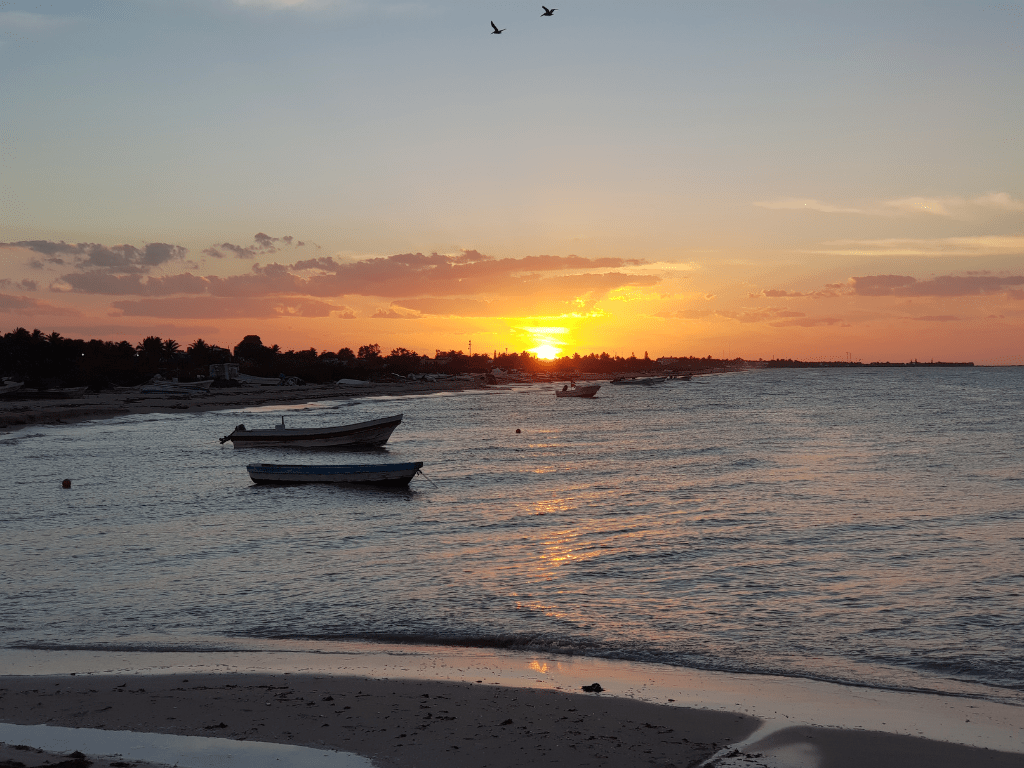
Visiting Yucatan’s colonial towns during the off-season can be a game-changer for your entire experience. Not only will you avoid the crowds and long lines, but you’ll also get a chance to truly soak up the local culture without feeling rushed or overwhelmed. Picture strolling through the cobblestone streets of Merida, with its colorful colonial buildings and lively markets, without having to navigate through throngs of tourists.
Or imagine exploring the ancient Mayan ruins in Izamal at your own pace, feeling like an intrepid explorer discovering hidden secrets of history. The off-season allows you to connect more deeply with the soul of Yucatan, as you immerse yourself in its rich tapestry of sights and sounds.
During this time, you’ll also have more opportunities to interact with locals who are not overwhelmed by hordes of visitors. In places like Valladolid or Ticul, where residents are known for their warm hospitality, chatting with them will give you precious insights into their customs and traditions that might not be readily available during peak tourist season.
You might stumble upon family-run eateries tucked away in narrow alleys that serve mouthwatering regional dishes passed down through generations. Exploring Yucatan’s colonial towns during this period also presents a unique chance to witness local festivities and celebrations that are deeply rooted in history and culture.
From religious processions to traditional dance performances, there’s always something happening in these vibrant towns. Plus, booking accommodations becomes easier during the off-season, allowing you to snag great deals on charming boutique hotels or cozy guest houses where friendly staff members will gladly share insider tips about must-visit local restaurants specializing in authentic Yucatecan cuisine.
One aspect worth mentioning is that visiting Yucatan’s cenotes—natural sinkholes filled with crystal-clear water—during the off-season can offer a more serene experience. Imagine taking a refreshing dip in Hoctun’s underground cenote, surrounded by the mystical beauty of nature, without having to share the space with a crowd of fellow tourists.
It’s a moment of tranquility that allows you to appreciate the wonders of Yucatan’s landscape without any distractions. Visiting Yucatan’s colonial towns during the off-season is an unparalleled opportunity to delve deeper into the heart and soul of this captivating region.
From Merida’s bustling markets to Valladolid’s enchanting streets and Ticul’s rich Mayan heritage, there is so much to explore and discover. So pack your bags and embark on an adventure that will not only satisfy your wanderlust but also leave you with a profound appreciation for Yucatan’s history, culture, and delectable cuisine.
Take Your Time and Explore Each Town at Your Own Pace
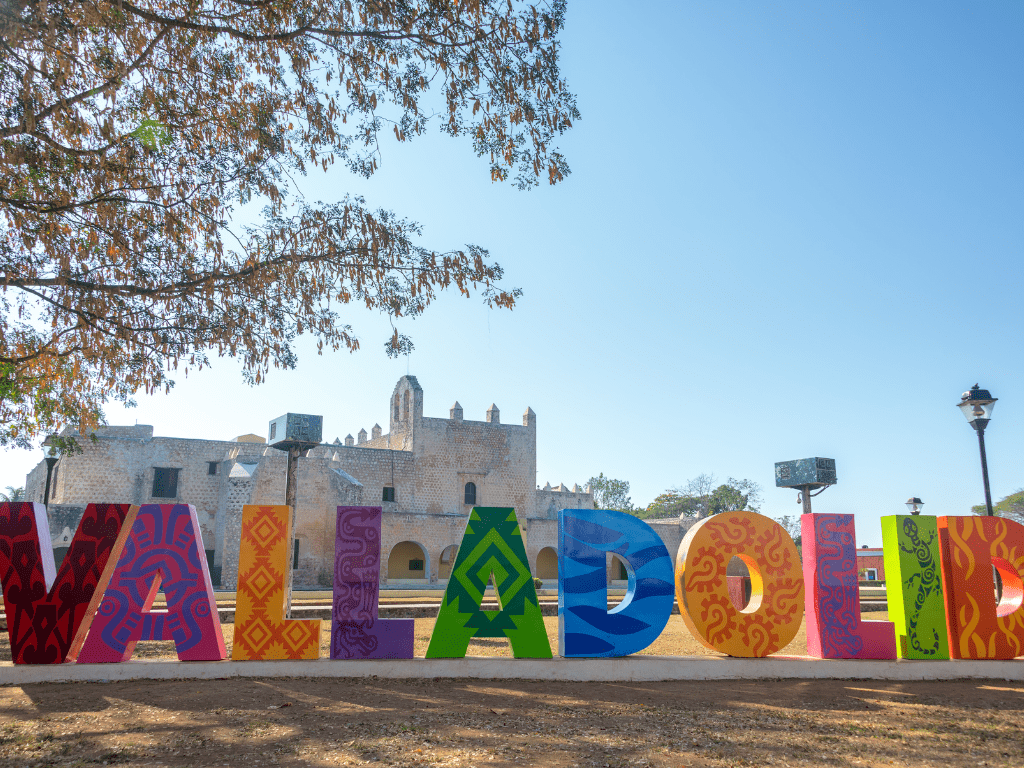
When it comes to exploring the colonial towns of Yucatan, one thing you must remember is to take your time and explore each town at your own pace. These charming towns have so much to offer, from their colorful streets lined with colonial architecture to their vibrant markets filled with traditional crafts and mouth watering local cuisine. So, why rush through it all?
Take a leisurely stroll through the bustling streets of Merida, the capital city of Yucatan. Immerse yourself in its lively atmosphere as you discover its rich history and cultural heritage.
If you find yourself in Valladolid, don’t be in a hurry to move on. This small town is bursting with charm and offers a mix of Mayan and colonial influences.
Take a walk around its central square, admire the stunning San Bernardino Convent, or visit the nearby Mayan ruins of Ek Balam for a glimpse into ancient history. In Izamal, also known as the “Yellow City,” lose yourself in its cobblestone streets adorned with vibrant yellow buildings that give this town its unique character.
For those who wish to venture off the beaten path, Ticul is a hidden gem worth exploring. This small town boasts well-preserved Mayan ruins and offers an authentic glimpse into local life.
Wander through its narrow streets and soak up the peaceful atmosphere while indulging in delicious street food like cochinita pibil or papadzules. If you have more time on your hands, make sure to visit Hoctun, a lesser-known town that boasts an intriguing underground cenote.
This natural wonder is not only beautiful but also holds significant cultural importance for the locals. Take a dip in its crystal-clear waters or simply marvel at the breathtaking surroundings.
So remember, when exploring Yucatan’s colonial towns, slow down and savor every moment. Allow yourself to be captivated by their unique charm as you delve into their rich history, immerse yourself in local culture, and indulge in the mouth watering flavors of traditional Yucatecan cuisine.
Whether it’s Merida, Valladolid, Izamal, Ticul, or Hoctun, each town has its own unique stories to tell and experiences to offer. Embrace the laid-back pace of life and let these hidden gems unfold before your eyes.
Talk to the Locals and Learn About Their History and Culture
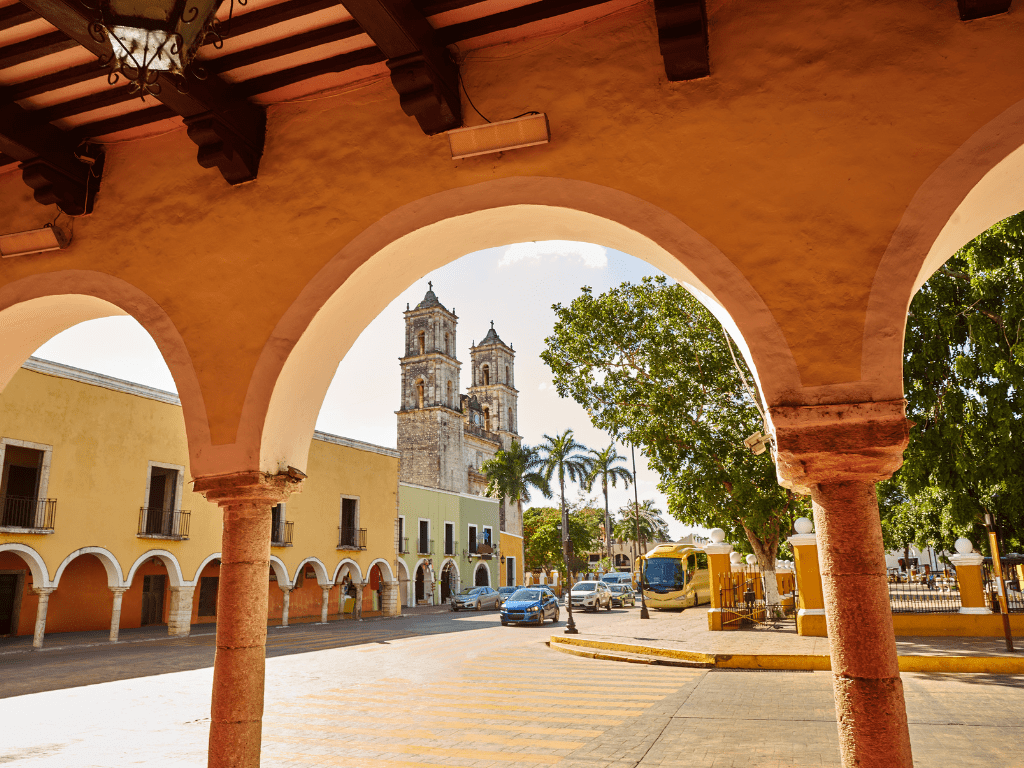
One of the most enriching aspects of exploring Yucatan’s colonial towns is the opportunity to engage with the locals and immerse yourself in their vibrant culture and history. As you stroll through the cobblestone streets of Merida, strike up a conversation with a friendly local vendor at one of the bustling markets.
They may share fascinating stories about their family’s traditional recipes passed down through generations or offer insights into the historical significance of certain dishes. In Valladolid, visit a traditional home-style restaurant where you can chat with the owner and learn about the town’s colonial heritage while savoring authentic Yucatecan flavors.
If you find yourself in Izamal, known as the “Yellow City” for its golden-hued buildings, strike up a conversation with a local artisan creating intricate crafts using ancient Mayan techniques. Their passion for preserving their cultural heritage will inspire you to delve deeper into Yucatan’s rich history.
As you venture further into Ticul, a small town renowned for its well-preserved Mayan temple complex, take advantage of opportunities to interact with locals during your exploration. Approach one of the site guides and ask them about the significance of these ancient ruins in Mayan culture.
They might regale you with legends and myths surrounding these temples or provide interesting insights into how they were used by ancient civilizations. But perhaps one unique way to both learn about history and connect with locals is by visiting Hoctun, a charming town famous for its underground cenote system.
As you descend into one of these mystical natural formations, accompanied by an experienced guide, take advantage of this intimate setting to engage in conversations about Hoctun’s past. Your guide might share tales of how cenotes played an integral role in Mayan rituals or explain how they were vital water sources during colonial times.
By talking to locals throughout your journey, not only will you gain valuable knowledge about Yucatan’s history and culture, but you’ll also form meaningful connections that will enhance your overall travel experience. So, seize every opportunity to engage with the warm and welcoming locals of Yucatan – they are the keepers of a rich heritage that will undoubtedly leave a lasting impression on you.
Conclusion

Exploring the colonial towns of Yucatan is an experience that should not be missed. The region’s rich history and cultural heritage come alive in these charming towns, offering a glimpse into the past while embracing the present.
Merida, with its vibrant markets and delectable street food, is a must-visit for any food lover. The bustling streets are filled with the aroma of sizzling tacos al pastor and the sweet scent of freshly made churros.
Valladolid, with its picturesque streets lined with colorful buildings, offers a perfect blend of Mayan and colonial influences. Here, you can indulge in traditional Yucatecan dishes such as cochinita pibil, a succulent slow-roasted pork dish marinated in citrus juices and spices.
If you’re looking for a truly unique culinary experience, Izamal should be on your list. Known as the “Yellow City,” this town not only dazzles visitors with its golden-hued architecture but also delights their taste buds with dishes like papadzules – rolled tortillas filled with hard-boiled eggs and smothered in pumpkin seed sauce.
Ticul may be a smaller town but it surprises visitors with its impressive underground cenotes where you can cool off after exploring Mayan ruins. Hoctun may be lesser-known to tourists but it boasts a fascinating underground cenote that is worth discovering.
Imagine swimming amidst ancient stalactites while immersing yourself in the natural beauty of Yucatan. As you travel through these colonial towns, take your time to soak up their charm and connect with the locals who are always eager to share stories about their town’s history and culture.
Whether you’re an adventurous foodie looking to try authentic Yucatecan cuisine or simply seeking to immerse yourself in Mexico’s rich colonial heritage–exploring these towns will leave an indelible mark on your senses and create lasting memories. So pack your bags, prepare your taste buds, and embark on an unforgettable culinary journey through the colonial towns of Yucatan.
